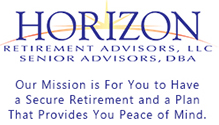Dave Mello
Horizon Retirement Advisors, LLC
457 Retirement Plan Option
A 457 Plan might be a good choice for your retirement planning

What Is A 457 Plan?
A 457 plan is a type of defined-contribution plan for employees of state and federal governments, agencies, and tax-exempt organizations. Contributions made to the plan with pre-tax money, earnings, and contributions are tax-deferred while under the plan, and the employee generally makes contributions. However, some plans do have contributions by employers as well.
What Are The Benefits Of A 457 Plan?
There are several benefits to this type of plan, the first being that contributions are not considered part of an employee’s salary for income tax. Earnings and contributions can grow tax-deferred without any income tax reduction, and employee contributions and earnings are 100 percent vested. There is no penalty for distributions made before age 59 ½, and the start of distributions can be delayed beyond 70 ½ if the plan participant continues to work.
What Are The Potential Drawbacks?
The chief potential drawback of a 457 plan is that there are usually no employee contributions, and when these types of contributions are allowed, they typically have vested requirements. Distributions of earnings and contributions under the plan are also taxed at an ordinary income rate. However, it should be noted that distributions under the plan can occur before retirement age without penalty.
As with most retirement savings plans, funds are not made available until termination of employment, retirement, death, or in the event of specific circumstances or unforeseen financial emergency as defined by the IRS.
Are There Catch Up Contributions Under A 457 Plan?
For employees aged 50 or older, catch-up contributions can be made to a 457 plan annually, with a contribution cap that varies by plan. This provision is applicable every year from age 50 until participation in the plan ceases. Unused deferrals from prior years are not needed to take advantage of the over 50 catch-up plan, and these contributions are not included in the total plan contribution limit.
Other employees can take advantage of a provision set in place by the IRS that allows them to make up for contributions that have not been previously deferred to your current employer’s deferred compensation plan. The maximum allowed amount is 100 percent of total unused deferrals or $15,000.00, whichever is greater. This catch-up has been applicable for any year since January 1st, 1979.
Retirement planning is important in ensuring financial stability for yourself and future generations. It is essential that you speak with your financial advisor before joining this or any other type of retirement plan.

Dave Mello
Horizon Retirement Advisors, LLC
707 Mount Rose St.
Reno, Nevada 98509
horizon@retirevillage.com
(775) 851-4754

Looking For Answers?
Download our Safe Money Guide and learn more about safe retirement options that can help you achieve your retirement goals safely - FREE!


